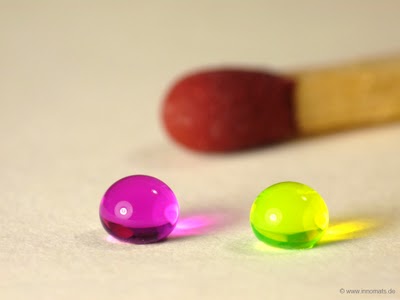Hydrophobic and Hydrophilic Surfaces: Water Marbles

Presented by Cool Science at the 2012 Philadelphia Science Festival Carnival!

[Shopping List: Super-Hydrophobic Aerogel granules; paper plates; Styrofoam plates; wax paper, aluminum foil; big, clear plastic cups; pipettes; Lotus and/or Nasturtium leaves; Nanotex fabrics; car wax/other hydrophobic substances; rags; paper towels; Purell; windex/other cleaner; food coloring]
- Use a pipette to transfer several drops of water onto a paper and Styrofoam plate. Shake the plate a bit, examining how the water reacts. What differences can you observe between water droplets on the two plates? Which plate seems to be more permeable to water?
- Rub a small amount of aerogel granules (about 1/4 - 1/2 teaspoon) onto a plate, making sure to crush the granules and coat the entire surface. (Note: any spots you fail to coat will not repel water!) Transfer several drops of water to the plate with a pipette and shake it briefly to see the water droplets roll around on the plate. Notice how the balls of water interact with the plate and each other. You can also rub some aerogel onto the table surface or your palm (don't let young children put it on their hand – they might forget to wash it off before eating!).
- Coat your fingertip with the aerogel and then submerge it in a cup of water. Can you see the silvery layer around your finger? Remove your finger and you will find that it is completely dry – the aerogel repelled all of the water!
What's Happening: Aerogel is a special substance made by extracting the liquid component of a typical gel (such as silica gel) and replacing it with air. Aerogel has excellent thermal insulating properties and is the least dense material known.
Hydrophobic substances repel water, and the name comes from the Greek stems "hydros" for water and "phobos" for fear. Hydrophilic substances attract water. Water is a polar molecule, having both positive and negative charges. Hydrophilic substances are also polar/charged, while hydrophobic substances are non-charged. Have you ever tried to combine oil and water, only to notice that after sitting for several minutes they will separate into two layers? The oil is non-charged and hydrophobic, and so prefers to be as separate from the water as possible. Since most important chemical reactions involve water (especially biochemical reactions), hydrophilic and hydrophobic interactions are extremely important to scientists and engineers.
While normally a hydrophilic substance, aerogels can be treated to act hydrophobic. The aerogel is treated to replace the polar hydroxyl groups (oxygen, hydrogen) with non-polar trimethylsilyl groups (silica, carbon, and hydrogen). Replacing just 20-30% of these groups will render the gel hydrophobic. It is so hydrophobic, in fact, that it has been termed super-hydrophobic. Adding drops of water to a surface coated with this special aerogel will cause the water to not just bead up, but actually ball up, so that as many water molecules as possible can be in contact with other water molecules and minimize their contact with the aerogel surface. The water droplets will roll around the aerogel surface like little glass marbles. Since the water cannot touch or "wet" the aerogel treated paper surface, its own surface tension forces will dominate and the water molecules will hold on to each other and pull the droplet into its minimum energy state, which is a sphere (i.e. minimizing its volume). This is somewhat similar to videos you may have seen made by astronauts on the space station, where they inject a little water into the air and it forms a sphere that floats and wobbles around under the weightless conditions, the droplets on our plate just have to contend with gravity as we aren't in a weightless environment.
Variations and Related Activities: Color the water with food coloring before dropping it onto the plates. When droplets of different colors combine, you will be able to see the colors slowly mix. Try to make a giant drop of water on the plate; this might require the use of a little more aerogel. If the water droplet becomes big enough you will be able to tear a hole in it by prodding with a pipette or finger. You can also put a little aerogel powder on the plate or table top and place a small drop of water on the powder. Roll it around with your pipette tip, coating as much of the water ball as possible, then gently roll it onto the bare tabletop. Notice that the ball will now roll easily over areas of the table that have not even been coated with aerogel. The powder that clings to the surface of water ball prevents it from contacting the table surface. You can also experiment with other surfaces, such as wax paper, aluminum foil, glass and plastics to determine if they are hydrophobic or hydrophilic. You can also find super-hydrophobic surfaces in nature, on lotus and nasturtium leaves. In fact this effect is often referred to as the "lotus effect." Finally, many clothes are now made with a special fabric called NanoTex, which has been treated to make it super-hydrophobics so that it is extremely water and stain repellent.
*Aerogel is not harmful, but all should wash their hands before eating with soap or an alcohol based hand cleanser.
Links to more information and activities
Our activity is based on this materials science blog from Germany:
http://blog.innomats.de/search/label/Aerogel%20Granules
and videos on their YouTube Channel:
http://www.youtube.com/user/InnovativeMaterials?feature=watch
Everything you ever wanted to know about aerogels:
http://www.aerogel.org/
Teachers can purchase Super-Hydrophobic Aerogel Granules here:
http://www.buyaerogel.com/?p=158
Teach Engineering lesson "Super-Hydrophobicity- The Lotus Effect":
http://www.teachengineering.org/view_lesson.php?url=collection/duk_/lessons/duk_surfacetensionunit_lessons/duk_surfacetensionunit_less4.xml
Nano-Lab Super-Hydrophobic Materials:
http://nanoyou.eu/en/component/content/article/87-hands-on-activities/502-experiment-with-superhydrophobic-materials.html?directory=4&Itemid=4
Superhydrophobic nanotechnology for fabrics and other applications:
http://www.sciencentral.com/articles/view.php3?article_id=218392126&language=english
http://www.nano.org.uk/news/225/
http://www.nano-tex.com/index.html
The "lotus effect":
http://en.wikipedia.org/wiki/Lotus_effect
As you saw in this activity, nasturtiums are similar to lotus and great plants for kids to grow. Nasturtim seeds look like little brains, they germinate and grow quickly and easily indoors or out just about anywhere, in relatively poor soils with little or no effort, the stems are very long and the leaves look very cool with the stem in the middle (called "peltrate" leaves, like lotus or lilly pads), the flowers are very colorful and pretty, both the flowers and leaves are edible (and very tasty), they attract aphids and several other insects (if you want to study them too), and of course the leaves are super-hydrophobic, so water drops roll off, the leaves have a silvery sheen when dunked under water and remain completely dry when pulled out. Wow- what a plant!
http://www.global-garden.com.au/gardenkids_grow4.htm#Growing%20Nasturtiums
An excellent video and experiment for kids using nasturtiums and other plants:
http://pbskids.org/dragonflytv/show/nasturtiumleaves.html
Cohesive forces and surface tension of water:
http://www.exploratorium.edu/ronh/bubbles/sticky_water.html
and of course our own experiment demonstrating surface tension of water:
http://www.coolscience.org/CoolScience/KidScientists/FloatDivePaperClip.htm
If you think our water marbels on a paper plate was cool, check out what surface tension does to water in space:
http://www.youtube.com/results?search_query=Surface+tension+of+water+in+microgravity
http://www.youtube.com/watch?v=s63JXdsL5LU&feature=related
And finally, off topic, but interesting-
While you often hear about "zero gravity" in space, this is not true. Zero gravity does not exist- at least not anywhere in our universe:
http://www.yalescientific.org/2010/10/mythbusters-does-zero-gravity-exist-in-space/
The Earth's gravity on board the space station is very nearly the same as it is for us on the surface. The space station and the water droplets you see in these videos are in free-fall (i.e. they are all falling towards Earth at the same velocity), not zero gravity, just as are the water droplets falling from a faucet:
http://www.youtube.com/watch?v=cJUnZAnSsIE
Learn more about free-fall:
http://science.howstuffworks.com/zero-g.htm
http://videolectures.net/mit801f99_lewin_lec07/
But if the space station is falling towards Earth due to gravity, why doesn't it crash? Because it is moving around the Earth very fast, so fast that as it falls the surface of the Earth curves away at the same rate:
http://cr4.globalspec.com/comment/10795/Re-A-Question-of-Orbital-Velocity
|